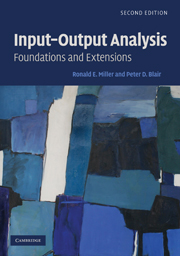Book contents
- Frontmatter
- Contents
- List of Figures
- List of Tables
- Preface
- 1 Introduction and Overview
- 2 Foundations of Input–Output Analysis
- 3 Input–Output Models at the Regional Level
- 4 Organization of Basic Data for Input–Output Models
- 5 The Commodity-by-Industry Approach in Input–Output Models
- 6 Multipliers in the Input–Output Model
- 7 Nonsurvey and Partial-Survey Methods: Fundamentals
- 8 Nonsurvey and Partial-Survey Methods: Extensions
- 9 Energy Input–Output Analysis
- 10 Environmental Input–Output Analysis
- 11 Social Accounting Matrices
- 12 Supply-Side Models, Linkages, and Important Coefficients
- 13 Structural Decomposition, Mixed and Dynamic Models
- 14 Additional Topics
- Appendix A Matrix Algebra for Input–Output Models
- Appendix B Reference Input–Output Tables for the United States (1919–2006)
- Appendix C Historical Notes on the Development of Leontief's Input–Output Analysis
- Author Index
- Subject Index
10 - Environmental Input–Output Analysis
Published online by Cambridge University Press: 05 June 2012
- Frontmatter
- Contents
- List of Figures
- List of Tables
- Preface
- 1 Introduction and Overview
- 2 Foundations of Input–Output Analysis
- 3 Input–Output Models at the Regional Level
- 4 Organization of Basic Data for Input–Output Models
- 5 The Commodity-by-Industry Approach in Input–Output Models
- 6 Multipliers in the Input–Output Model
- 7 Nonsurvey and Partial-Survey Methods: Fundamentals
- 8 Nonsurvey and Partial-Survey Methods: Extensions
- 9 Energy Input–Output Analysis
- 10 Environmental Input–Output Analysis
- 11 Social Accounting Matrices
- 12 Supply-Side Models, Linkages, and Important Coefficients
- 13 Structural Decomposition, Mixed and Dynamic Models
- 14 Additional Topics
- Appendix A Matrix Algebra for Input–Output Models
- Appendix B Reference Input–Output Tables for the United States (1919–2006)
- Appendix C Historical Notes on the Development of Leontief's Input–Output Analysis
- Author Index
- Subject Index
Summary
Introduction
Since the late 1960s the input–output framework has been extended by many researchers to account for environmental pollution generation and abatement associated with interindustry activity. Leontief (1970) himself provided one of the key methodological extensions that has since been applied widely and extended further. In this chapter we will examine several of the most prominent environmental input–output formulations and discuss many of the features, advantages, and limitations of each. Much like the discussion in Chapter 9 – modification of the traditional Leontief model to deal with energy flows – in the environmental extensions we must include some additional conditions in order to enforce consistency among interindustry production, pollution generation, and pollution abatement activities.
Basic Considerations
A principal problem to be resolved in environmental models is the appropriate unit of measurement of environmental (or ecological) quantities – for example, in monetary or physical units. In the alternatives we consider here, we will see formulations using each approach. We will examine three basic categories of environmental input–output models:
Generalized Input–Output Models. These are formed by augmenting the technical coefficients matrix with additional rows and/or columns to reflect pollution generation and abatement activities. We explore two variations on such models – one aimed at analysis of impacts and another aimed at planning applications.
Economic–Ecologic Models. These models result from extending the interindustry framework to include additional “ecosystem” sectors, where flows will be recorded between economic and ecosystem sectors along the lines of an interregional input– output model.
Commodity-by-Industry Models. Such models express environmental factors as “commodities” in a commodity-by-industry input–output table, as described in Chapters 4 and 5.
- Type
- Chapter
- Information
- Input-Output AnalysisFoundations and Extensions, pp. 446 - 498Publisher: Cambridge University PressPrint publication year: 2009
- 1
- Cited by

